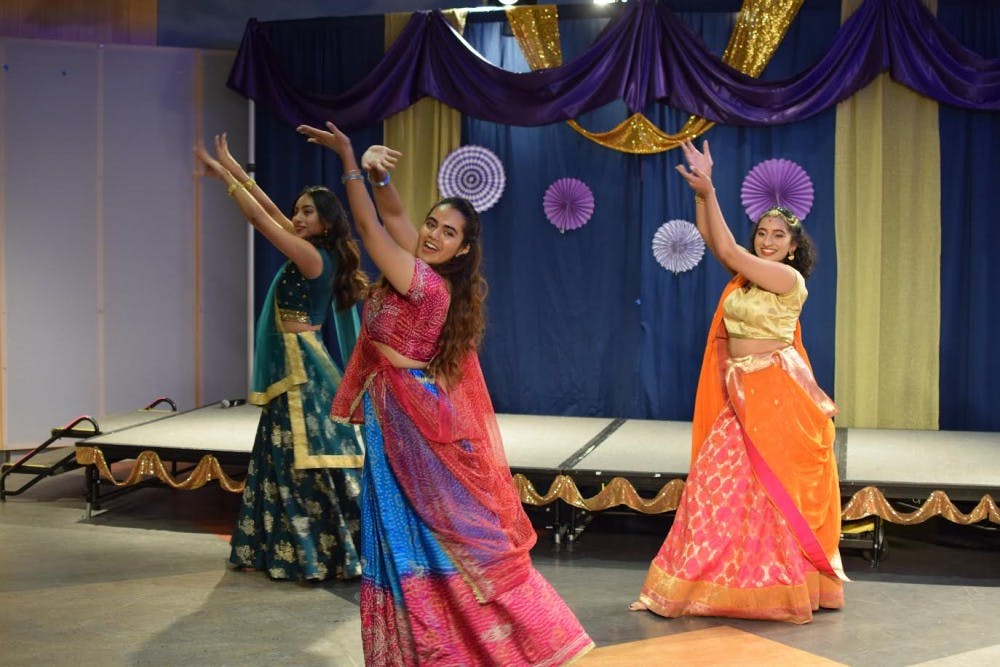Students clad in vibrant lehengas, saris and kurtas alike filled the Tavern on Oct. 19 for “The Royal Jalwa,” an event hosted by AU’s South Asian Student Association. Students who walked the runway of the event’s fashion show wore colorful garments, jewelry pieces and sequined shawls that represented distinct elements of their culture.
Lehenga
Janvi Sai, a freshman in the College of Arts and Sciences, chose to wear a lehenga decorated with orange, yellow and pink. Sai said a lehenga is an embroidered two-piece outfit, a skirt and a blouse, often complimented by a dupatta, a long scarf.
“The dupatta for the lehenga was silk. Banarasi silk, I think,” she said. “I was wearing golden ruby jewelry as well. The outfit and the jewelry were both from Hyderabad; it made me nostalgic.”
Sai said she grew up with these clothes. Her mother often designed costumes for her Bharatanatyam performances, an Indian classical dance form based on a Hindi concept called “Natya Shastra.” Dancers would typically wear long, pleated costumes embellished with embroidery.
For these performances, Sai said she would wear her embroidered costume, paint on her hands, bells on her ankles and jasmine flowers in her hair. Sai’s mother would design intricate costumes through needlework and chose accessories to match.
“When it comes to haute couture, South Asian clothing may not come to people’s minds,” Sai said. “My mother’s designs changed the game and fueled my fascination for South Asian clothing.”
Sari
Syeda Siddiqi, a junior in the School of International Service, wore a sari to Jalwa. A sari is considered traditional Indian dress, made up of long pieces of cloth and fabric. Wanting to make her outfit a bit sultry, she chose a red and black garment and gold jewelry pieces to match. She said that these events and these clothes are some of the ways she maintains connection with her culture.
The sari can be traced back to Tamil poetry, which described women in elegant gowns and wraps. It eventually made its way to North and South Indian fashion. There are many legends about the creation of the sari.
One suggests that a weaver daydreamed about a beautiful woman while using his loom. Due to his absent minded daydreams, he kept using his loom until he realized that the garment had become yards long.
Kurtas
A kurta is a long garment worn usually by men, while women typically wear kurtis. Kurtas and kurtis are worn throughout South Asia, in Bangladesh, Pakistan, India and Nepal, just to name a few. The main discrepancy between the two is based on the length of the garment. Kurtas and kurtis can vary in length, typically near the knees. They can be dressed up or down worn with a churidar, salwar or a more modern pair of jeans.
A churidar is a trouser that is more tight, similar to leggings. The salwar, on the other hand, is looser and a bit baggy.
Tikkas
Sai wore a tikka to the event, a headpiece made of gemstones such as ruby or gold. Maang tikkas are used as accessories for brides as well. Hindu mythology writes that this spot on the forehead is a “third eye” resting on the sixth chakra, which holds power of concentration and emotion. However, tikkas are now becoming an accessory that is worn at many events to evoke fashionability or elegance.
Sai said that South Asian fashion represents the diversity that exists in the wide region. With the many subcultures, peoples and languages in South Asia, Sai said, comes various styles and forms of clothing. She said that the lehenga she wore to perform with her dance group could be considered more North Indian.
“I also wore a lehenga because I’m fascinated by South Asian history and how lehengas date back to the Mughal era,” Sai said. “I find South Asian clothing to be a reflection of our history and heritage.”
Nostalgia often occurs for Sai during these events. The clothing frequently reminds her of her memories in India and the city of Hyderabad. Sai said she then grew up in a primarily-white town that did not offer many opportunities for this kind of expression.
“I’m appreciative of the experiences that I’ve had with South Asian culture at AU because I didn’t really have that back home. I had to make it for myself. I was really among the only people of color or even South Asians in my high school in my town,” Sai said. “I was always constantly being told by peers and teachers, that they wanted me to assimilate, and it was kind of this problem that they had with me. But no, I'm going to embrace what's different about me and my culture.”
Students say that AU is not exempt from this type of South Asian erasure. In October, a group entitled Viva Kultura visited Kay Spiritual Life Center for a show about “Hinduism and Indian culture.” Many students were upset by Viva Kultura’s inclusion of several non-South Asian dancers in their performance.
Maya Krishnan, the president of the South Asian Student Association, published an opinion piece in The Eagle shortly after the event criticizing the group and the University for allowing them on campus.
“AU does not have a large South Asian population, and there is minimal representation of South Asian culture in academia and coursework, even within curriculum of courses hosted in the School of International Service,” Krishnan wrote. “With such little representation, whatever exposure there is needs to be accurate.”
Siddiqi said that events such as Jalwa are integral for herself and other students at AU, as there are not many opportunities to celebrate South Asian culture through fashion, music and dance.
“It’s important that we refuse South Asian invisibility on campus,” she said. “It reminds us that our culture is important.”
This article originally appeared in The Eagle's November 2018 fall print edition.





